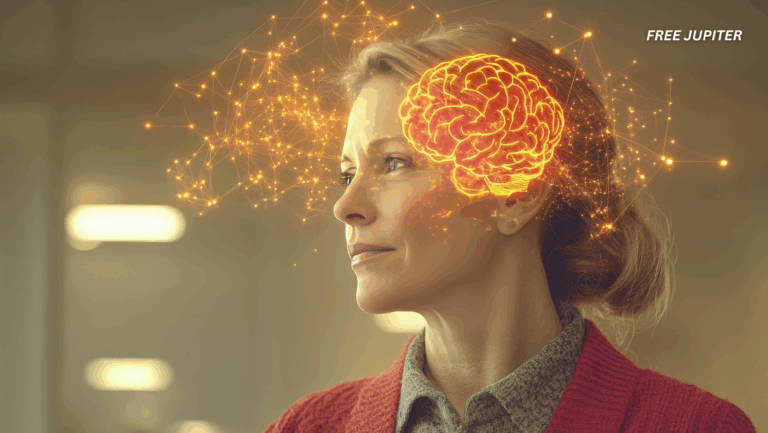Friendly Note: FreeJupiter.com shares general info for curious minds 🌟 Please fact-check all claims—and always check health matters with a professional 💙
Our ability to distinguish what is real from what is imagined is fundamental to how we navigate the world. Recent research led by neuroscientists at University College London (UCL) has shed new light on the brain mechanisms that enable this crucial distinction. This discovery not only deepens our understanding of human cognition but also holds promise for improving treatments for conditions where this boundary becomes blurred, such as in Parkinson’s disease and schizophrenia.
The Challenge of Reality Versus Imagination
When you picture an object in your mind’s eye—say, an apple—the brain activates many of the same regions involved in actually seeing that apple. This overlap has long posed a question to scientists: how does the brain decide whether a visual experience is externally sourced or internally generated? Until now, the neural basis for this differentiation remained elusive.
Dr. Nadine Dijkstra and her colleagues at UCL designed a study to unravel this mystery by examining how specific brain regions respond when people view and imagine visual patterns. Their findings, recently published in Neuron, reveal a dynamic interplay between brain areas that assess the vividness of visual imagery and those that make a binary decision about its reality.
The Experimental Approach: Seeing and Imagining Lines
The study involved 26 volunteers who participated in a carefully crafted visual task while undergoing functional magnetic resonance imaging (fMRI) to monitor brain activity in real time. Participants viewed a series of grey squares on a screen, some of which contained faint diagonal lines, while others did not. Simultaneously, they were instructed to imagine diagonal lines on each square, regardless of whether the lines were physically present.
After each trial, participants rated the vividness of the lines they perceived on a scale from 1 (barely visible) to 4 (very vivid) and indicated whether they believed the lines were real or imagined. This design allowed researchers to compare brain activity associated with actual perception versus imagination and to see how vividness influenced the participants’ judgments.
Read more: Things That Will Make An Emotionally Intelligent Person Instantly Uncomfortable
Fusiform Gyrus: Tracking Visual Vividness
One of the key discoveries was the role of the fusiform gyrus, a brain region located beneath the temples on the underside of the temporal lobe. Known primarily for its involvement in face recognition and complex visual processing, the fusiform gyrus was found to be highly active not only when participants saw the diagonal lines but also when they imagined them vividly.
Interestingly, the strength of activity in this region predicted how vividly participants experienced the lines, regardless of whether the lines were physically present. When the fusiform gyrus showed strong activation, participants were more likely to report that the lines were real, even if they were only imagined.
This finding suggests that the brain uses the intensity of sensory signals in the fusiform gyrus as a cue to determine reality. Usually, activity in this area is weaker during imagination than during actual perception, which helps the brain keep real and imagined experiences separate. However, when imagination becomes particularly vivid, this distinction can blur, leading to confusion between what is real and what is not.
Professor Steve Fleming, senior author of the study, noted that the observed brain activity aligned with predictions from computational models simulating how the brain distinguishes internal from external experiences.
Anterior Insula: The Reality Gatekeeper
Beyond the fusiform gyrus, the study identified the anterior insula as a crucial partner in determining the reality status of a visual experience. The anterior insula is part of the prefrontal cortex, a brain region involved in higher-order functions such as decision-making, problem-solving, and self-awareness.
When activity in the fusiform gyrus exceeded a certain threshold, it triggered increased activation in the anterior insula. This region appeared to act as a gatekeeper, integrating signals from the fusiform gyrus and making a binary judgment: is the visual experience real or imagined?
Dr. Dijkstra explains, “The anterior insula seems to monitor sensory signals and participate in the decision-making process about reality. It’s as if it receives input from the fusiform gyrus and then determines whether to classify the experience as real.”
Professor Fleming adds that these brain areas are also involved in metacognition—the ability to reflect on one’s own thoughts and experiences—which aligns with their role in evaluating the authenticity of sensory information.
Read more: Questions That Introverts Hate Always Being Asked, According To Psychology
Implications for Hallucinations and Psychiatric Disorders
The ability to distinguish imagination from reality can break down in certain psychiatric and neurological conditions, leading to hallucinations where individuals perceive things that are not present in the external environment. This is common in disorders such as schizophrenia and Parkinson’s disease.
The new findings provide a neural framework for understanding how such hallucinations might arise. For example, in people prone to hallucinations, the fusiform gyrus might become overly active during imagination, or the anterior insula might fail to correctly interpret the signals it receives, leading to false perceptions of reality.
Dr. Dijkstra suggests, “If the fusiform gyrus is too strongly activated during mental imagery, or if the anterior insula does not properly monitor these signals, the brain may mistake imagination for reality.”
This insight opens avenues for developing targeted therapies that could modulate activity in these brain regions to reduce hallucinations or improve reality monitoring.
Broader Significance: From Virtual Reality to Cognitive Science
Beyond clinical applications, understanding how the brain separates real from imagined experiences has implications for emerging technologies like virtual reality (VR). As VR environments become increasingly immersive, knowing how and when the brain treats imagined experiences as real can inform design principles that enhance user experience without causing disorientation or confusion.
Moreover, this research enriches cognitive science by elucidating fundamental mechanisms of perception, imagination, and self-awareness. It highlights how the brain reuses perceptual resources for imagination while employing higher-order control systems to maintain a boundary between internal and external worlds.
Future Directions: Exploring Reality Monitoring in Disease
Building on these discoveries, Dr. Dijkstra’s team is now investigating how this pathway functions in individuals with Parkinson’s disease, a condition often accompanied by visual hallucinations. By comparing brain activity patterns between healthy individuals and patients, researchers hope to pinpoint specific dysfunctions in the fusiform gyrus-anterior insula network.
Such studies could lead to biomarkers for early diagnosis and novel interventions that restore the brain’s ability to accurately distinguish reality from imagination.
Read more: The ‘Alien Language’ Problem That Has Stumped Mathematicians For Decades May Finally Have A Solution
Understanding the Brain’s Reality-Checking System
In summary, this groundbreaking research reveals that the brain’s judgment of reality relies on a delicate balance between sensory vividness and cognitive evaluation. The fusiform gyrus tracks how vividly we experience visual stimuli—whether real or imagined—while the anterior insula acts as a critical evaluator, deciding if these experiences correspond to the external world.
This neural partnership forms a reality-checking system that is essential for coherent perception and mental health. When this system falters, as in hallucinations, the consequences can be profound.
As neuroscientists continue to explore this pathway, the hope is to translate these insights into practical benefits for patients and to deepen our understanding of the human mind’s remarkable capacity to navigate between imagination and reality.










